
Uniforms & Insignia | Ranks & Organization | Misc. | Contact
Sections: 1864 | 1867 | 1869 | 1878 | 1883 | 1897 | 1898 | 1899 | 1900 | 1901 | 1905 | 1908 | 1909 | 1913 | 1915
The original warrant officers of the U.S. Navy (boatswains, gunners, carpenters and sailmakers) were distinguished for many years by plain, unadorned uniforms without the insignia and trim of commissioned officers. In the uniform regulations of 1852, warrant officers were authorized to wear gold-laced buttonholes on each side of the collar for full dress, but nothing was said about undress uniforms.1 Period photos indicate that plain frock coats were commonly worn. The first regulations to differentiate the different warrant ranks were those of January 1864.
Though masters' mates (later simply mates) were not always appointed by warrant, their uniforms were generally regulated similarly to those of warrant officers, and so will also be considered here.
The Civil War brought many changes to the Navy's uniforms, and in 1864 regulations appeared that were the first to authorize insignia that would distinguish the different warrant officers from each other.2 On the navy blue frock coat – the everyday dress of the naval officer – the warrant officers were authorized to wear shoulder straps of plain gold lace, three-quarters of an inch wide. Boatswains and gunners, as line officers, were to wear the newly-introduced star on the lower sleeve. Carpenters and sailmakers wore plain sleeves. To distinguish the different specialties, boatswains' shoulder straps were to have a silver "B" in the center and carpenters' a "C" while the other two officers' straps were to be plain. Mates and clerks wore single-breasted frock coats rather than double-breasted.
| cap badge |  |
|||||
| shoulder straps |  |
 |
 |
 |
||
| sleeve | 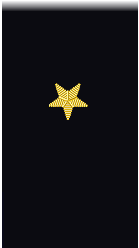 |
 |
 |
 |
 |
 |
| Boatswain | Gunner | Carpenter | Sailmaker | Clerk | Master's Mate | |
The warrant insignia of 1864 stayed in place with the illustrated uniform regulations of 1866. In 1867, however, a general order authorized shoulder straps for clerks and mates, making their insignia the same as carpenters and gunners.3
| cap badge |  |
|||||
| shoulder straps |  |
 |
 |
 |
 |
 |
| sleeve |  |
 |
 |
 |
 |
 |
Boatswain | Gunner | Carpenter | Sailmaker | Clerk | Master's Mate |
In March of 1869 Navy Department General Order 90 eliminated shoulder straps for warrant officers.4 Instead, they were ordered to wear devices on the collar of the frock coat. Boatswains and gunners wore a star, similar to that on the sleeve, and carpenters and sailmakers wore a lozenge or diamond. Once again there was no provision to distinguish all the warrant ranks from each other. Clerks and mates were to wear a doulbe-breasted frock coat similar to other officers, but with medium-sized instead of large buttons. They were also to wear the line star on the sleeve. New cap devices were also introduced: crossed anchors for warrant officers and a plain anchor for mates. On the sack coat, worn as "working dress" and off duty, warrant officers and mates wore no insignia except for the line star if appropriate.
| cap badge |  |
 |
 |
|
| frock coat collar (right side) |
 |
 |
 |
 |
| sleeve |  |
 |
 |
 |
| Boatswain, Gunner | Carpenter, Sailmaker | Clerk | Mate | |
In January 1877 a new service dress coat was introduced for commissioned officers of the navy.5 More military in design that the civilian-derived sack coat which it replaced, it was trimmed with black mohair braid and had a standing collar with rank devices. It would be pattern for officer's service dress for more than forty years. In October 1878 warrant officers and paymaster's clerks were authorized to wear the new service coat, with the same devices on the standing collar as were worn on the frock coat collar.6
The uniform regulations of 1883 introduced different devices for each warrant specialty.7 The new insignia would be in silver for those warrant officers who had 20 years seniority in grade, and in gold by others. In addition to the frock coat collar, the new insignia would be worn on the standing collar of the new blue service coat. The insignia for sailmaker was the lozenge formerly used for both sailmakers and carpenters. For the first time, Paymaster's Clerks' insignia was grouped together with warrant officers, including a common cap device, though the Paymaster's Clerks were not authorized the silver devices for long service.
| cap badge |  |
|||||
| frock coat collar (right side) |
 20 years in rank  under 20 years |
 20 years in rank  under 20 years |
 20 years in rank  under 20 years |
 20 years in rank  under 20 years |
 |
 20 years in rank  under 20 years |
| blue service coat collar (right side) |
 20 years in rank  under 20 years |
 20 years in rank  under 20 years |
 20 years in rank  under 20 years |
 20 years in rank  under 20 years |
 |
 20 years in rank  under 20 years |
| frock coat sleeve |  |
 |
 |
 |
 |
 |
| Boatswain | Gunner | Carpenter | Sailmaker | Paymaster's Clerk | Mate | |
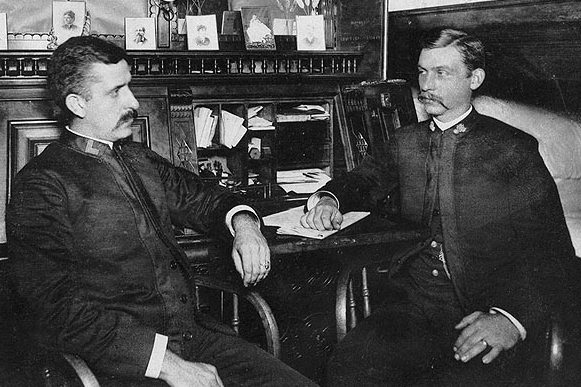 |
| A carpenter and gunner of USS Boston, in 1888, wearing blue service dress of the 1883 regulation. No devices were worn on the sleeves of the service coat till 1897. Photo from the Naval History and Heritage Command. |
The uniform regulations of 1897 prescribed the same gold stripes and corps devices for the blue service coat as worn on the frock coat.8 For warrant officers, this meant that boatswains and gunners began to wear the line star on the service coat sleeve.
In May 1898 warrant machinists were authorized to be appointed directly from civilian life for temporary service in the Spanish-American War. In June they were authorized a four-bladed propeller insignia.3 The naval aspect of the war did not reach the scale originally anticipated, and the temporary machinists were all discharged within the year.
| cap badge |  |
| frock coat collar (right side) |
 |
| blue service coat collar (right side) |
 |
| sleeve |  |
| Warrant Machinist |
Some significant changes were reflected in the uniform regulations of 1899.9 To give long-serving warrant officers the prospect of promotion, the Naval Personnel Act of 1899 had authorized the ranks of chief boatswain, chief gunner, chief carpenter, and chief sailmaker.10 These were commissioned grades that ranked with but after ensigns. The sleeve insignia adopted for these new ranks was a half-inch gold stripe, similar to an ensign's, but broken with segments of blue silk. For collar insignia, commissioned warrant officers used the silver devices previously worn by warrant officers of 20 years service.
The permanent position of warrant machinist and pharmacist were also authorized, warrant machinists using a gold version of the Engineer Corps oak leaves, and pharmacists a Geneva cross.
Shoulder marks for wear on white uniforms were introduced for commissioned officers in 1899, but were not authorized for grades below ensign.
| cap badge |  |
|||
| frock coat collar (right side) |
 |
 |
 |
 |
| blue service coat collar (right side) |
 |
 |
 |
 |
| sleeve | 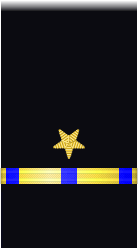 |
 |
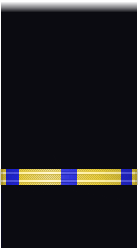 |
 |
| Chief Boatswain | Chief Gunner | Chief Carpenter | Chief Sailmaker | |
| cap badge |  |
|||||||
| frock coat collar (right side) |
 |
 |
 |
 |
 |
 |
 |
 20 years in rank  under 20 years |
| blue service coat collar (right side) |
 |
 |
 |
 |
 |
 |
 |
 20 years in rank  under 20 years |
| sleeve |  |
 |
 |
 |
 |
 |
 |
 |
| Boatswain | Gunner | Carpenter | Sailmaker | Warrant Machinist | Pharmacist | Paymaster's Clerk | Mate | |
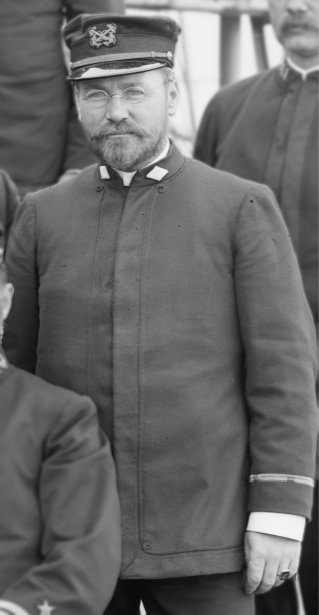 |
| A chief sailmaker in the commissioned warrant officer's uniform prescribed between 1899 and 1901, with silver collar devices, broken sleeve stripe and gold crossed anchor cap badge. Photo from the Library of Congress Prints & Photographs Online Catalog. |
In January 1900 the insignia for warrant machinist was changed to a three-bladed propeller.3
| cap badge |  |
| frock coat collar (right side) |
 |
| blue service coat collar (right side) |
 |
| sleeve |  |
| Warrant Machinist |
In 1901 a new order revising the uniform regulations brought chief warrant officers' uniforms into line with those of other commissioned officers with the authorization of a new cap badge, shoulder straps and shoulder marks.11 As the shoulder straps would now be worn on the frock coat, the frock coat collar devices were deleted for chief warrant officers. Shoulder marks were authorized only for commissioned warrant officers; white uniforms for warrant officers remained without insignia.
| cap badge |  |
|||
| blue service coat collar (right side) |
 |
 |
 |
 |
| shoulder straps |  |
 |
 |
 |
| shoulder marks |  |
 |
 |
 |
| sleeve |  |
 |
 |
 |
| Chief Boatswain | Chief Gunner | Chief Carpenter | Chief Sailmaker | |
| cap badge |  |
|||||||
| frock coat collar (right side) |
 |
 |
 |
 |
 |
 |
 |
 20 years in rank  under 20 years |
| blue service coat collar (right side) |
 |
 |
 |
 |
 |
 |
 |
 20 years in rank  under 20 years |
| sleeve |  |
 |
 |
 |
 |
 |
 |
 |
| Boatswain | Gunner | Carpenter | Sailmaker | Warrant Machinist | Pharmacist | Paymaster's Clerk | Mate | |
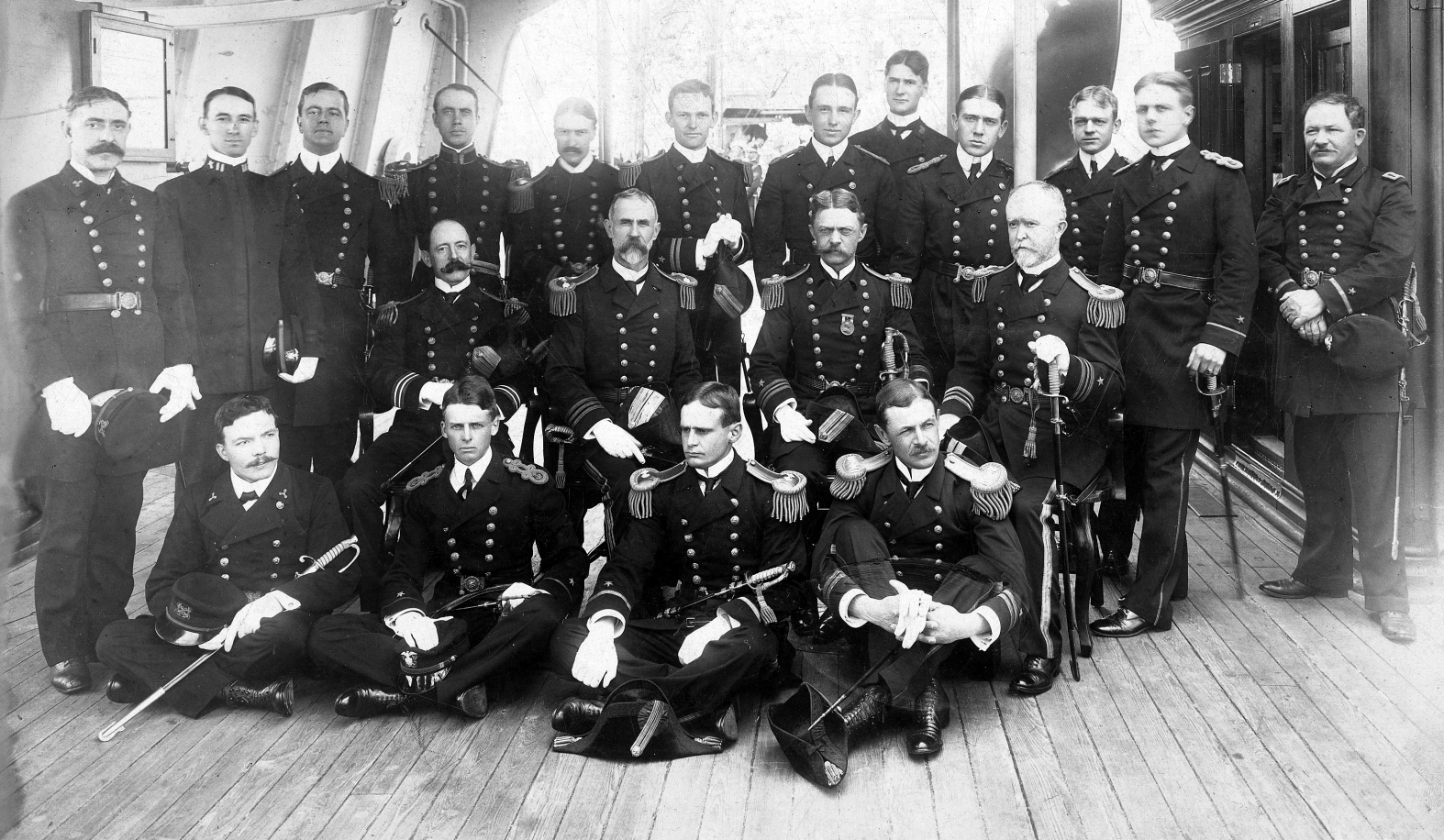
|
||
| Officers of USS Chicago in full dress uniform (except for chaplain) circa 1903. The full dress of commissioned warrant and warrant officers was the same as their undress uniform and did not include cocked hats, epaulettes, dress belts or gold-laced trousers. Details from the photo below. Photo from the Naval History and Heritage Command. |
The Naval Personnel Act of 1899 allowed officers who had served "with a creditable record" in the Civil War to be advanced to the next higher rank upon retirement. Commissioned warrant officers to whom this applied would rank with lieutenants (junior grade), and the 1905 uniform regulations prescribed insignia for these officers should they have occasion to wear uniform in retirement.12 The 1905 Navy Register listed 22 retired officers in this category.13 Provisions for such insignia were included in the uniform regulations until 1922.
| cap badge |  |
|||
| blue service coat collar (right side) |
 |
 |
 |
 |
| shoulder straps |  |
 |
 |
 |
| shoulder marks |  |
 |
 |
 |
| sleeve | 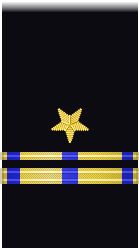 |
 |
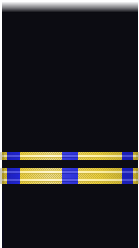 |
 |
| Chief Boatswain, retired with the rank of lieutenant (junior grade) | Chief Gunner, retired with the rank of lieutenant (junior grade) | Chief Carpenter, retired with the rank of lieutenant (junior grade) | Chief Sailmaker, retired with the rank of lieutenant (junior grade) | |
A 1908 change to the 1905 edition of the uniform regulations authorized shoulder marks for warrant officers, as commissioned warrant officers had worn since 1901. Corps devices were also introduced to CWO and WO shoulder marks, somewhat diverging their shoulder and sleeve insignia and resulting in a "two-tone" appearance for CWOs.14 As the new devices would take the place of the line star they had formerly worn on their shoulder marks, a small contrasting star was added to the devices of line commissioned warrant and warrant officers. The same order changed the style of the frock coat from one with nine pairs of buttons to one with five pairs and a different style of lapel and collar.
| cap badge |  |
|||
| blue service coat collar (right side) |
 |
 |
 |
 |
| shoulder straps |  |
 |
 |
 |
| shoulder marks |  |
 |
 |
 |
| sleeve |  |
 |
 |
 |
| Chief Boatswain | Chief Gunner | Chief Carpenter | Chief Sailmaker | |
| cap badge |  |
|||||||||
| frock coat collar (right side) |
 |
 |
 |
 |
 |
 |
 |
|
||
| blue service coat collar (right side) |
 |
 |
 |
 |
 |
 |
 |
 20 years in rank  under 20 years |
||
| shoulder marks |  |
 |
 |
 |
 |
 |
 |
|
||
| sleeve |  |
 |
 |
 |
 |
 |
 |
 |
||
| Boatswain | Gunner | Carpenter | Sailmaker | Warrant Machinist | Pharmacist | Paymaster's Clerk | Mate | |||
In March 1909 an act of Congress shortened the title of "warrant machinist" to just "machinist," and provided for the commissioned warrant rank of chief machinist. In December 1909 machinists and chief machinists were classified as line officers and the line star was added to their insignia.3
| cap badge |  |
 |
| frock coat collar (right side) |
 |
 |
| blue service coat collar (right side) |
 |
 |
| shoulder straps |  |
|
| shoulder marks |  |
 |
| sleeve |  |
 |
| Chief Machinist | Machinist |
A new edition of uniform regulations was issued in January 1913 and contained several changes.15 Chief pharmacists had been authorized in August 1912, and the new order not only provided for this new rank but changed the pharmacist's device from the Geneva cross to a caduceus. Shoulder straps were eliminated for all officers which, for commissioned warrant officers, meant a return of their corps devices to the frock coat collar. Contrasting stars, previously worn only on shoulder marks, were also added to collar devices of line commissioned warrant and warrant officers. The shoulder marks, adopted in 1899, were eliminated for white uniforms in favor of white cloth shoulder loops worn with metal pin corps insignia. The latter development was short lived: The shoulder marks were restored by a change order six months later.16
| cap badge |  |
|||||
| frock coat collar (right side) |
 |
 |
 |
 |
 |
 |
| blue service coat collar (right side) |
 |
 |
 |
 |
 |
 |
| shoulder strap |  |
 |
 |
 |
 |
 |
| sleeve |  |
 |
 |
 |
 |
 |
| Chief Boatswain | Chief Gunner | Chief Machinist | Chief Carpenter | Chief Sailmaker | Chief Pharmacist | |
| cap badge |  |
|||||||||
| frock coat collar (right side) |
 |
 |
 |
 |
 |
 |
 |
|
||
| blue service coat collar (right side) |
 |
 |
 |
 |
 |
 |
 |
 20 years in rank  under 20 years |
||
| shoulder strap |  |
 |
 |
 |
 |
 |
 |
|
||
| sleeve |  |
 |
 |
 |
 |
 |
 |
 |
||
| Boatswain | Gunner | Machinist | Carpenter | Sailmaker | Pharmacist | Paymaster's Clerk | Mate | |||
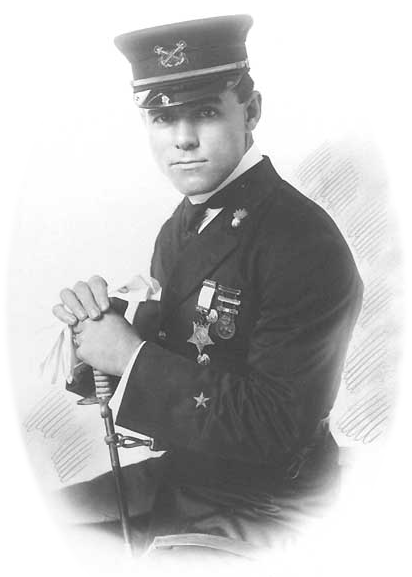 |
| Medal of Honor recipient Abraham DeSomer wearing the full dress uniform of a gunner as prescribed by the 1913 uniform regulations; note the contrasting star on the collar device. Photo from the Naval History and Heritage Command. |
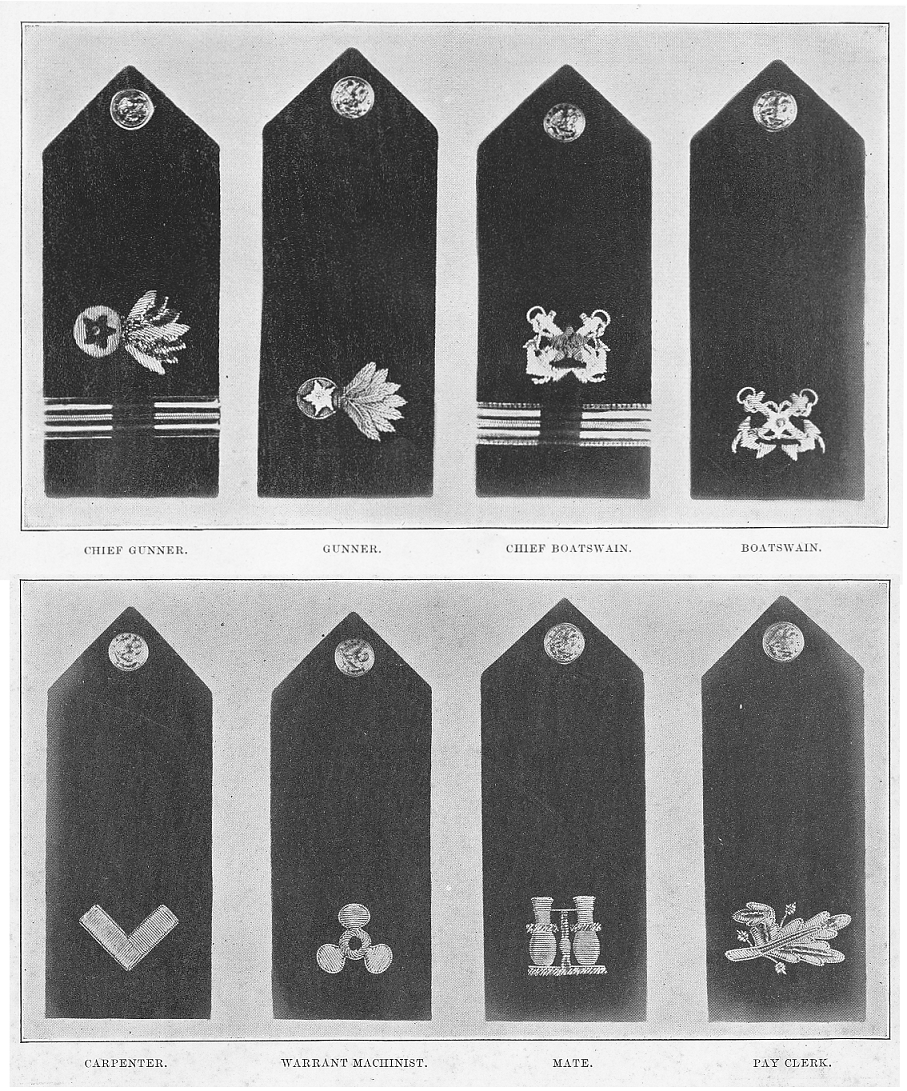 |
| Commissioned warrant and warrant shoulder marks as illustrated in the order that restored them to the uniform regulations, Change No. 1 of July 1913. The photographs were the same as those used in Change No. 4 of 1908, so the insignia and title of the machinist do not reflect the changes made in 1909. Author's collection. |
In March 1915, Congress officially changed the title of paymaster's clerk to "pay clerk," though in practice that term had been in use for some time, and authorized the commissioned warrant rank of chief pay clerk.17 The corps device for chief pay clerks was gold, the same as for pay clerks, the change order noting "the uniform of Chief Pay Clerk differs from that of Pay Clerk by the addition of the sleeve stripe only." This avoided using the same collar device in silver, which was the insignia of commissioned Pay Corps officers of ensign rank.
| cap badge |  |
 |
| frock coat collar (right side) |
 |
 |
| blue service coat collar (right side) |
 |
 |
| shoulder mark |  |
 |
| sleeve |  |
 |
| Chief Pay Clerk | Pay Clerk |
All text and images © Justin T. Broderick, 2014 unless otherwise indicated.